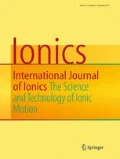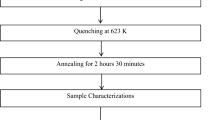Abstract
CoO and Li2O mixed with borotellurite glasses in the compositions, (B2O3)0.2-(TeO2)0.3-(CoO) x -(Li2O)0.5−x, where x = 0.05, 0.10, 0.15, 0.20, 0.25, 0.30, 0.35, 0.40, 0.45, and 0.50 were synthesized by fast cooling the melt to room temperature. Absence of crystalline phases in the samples was confirmed by X-ray diffraction studies. Changes in dielectric properties with frequency and temperature over wide ranges have been measured. Dielectric constant and loss increased with increase in CoO content. AC conductivity has been analyzed using Mott’s small polaron model and activation energy was determined. Activation energy decreased and conductivity increased with increase in CoO content up to 0.3 mole fractions, and they behaved oppositely for higher concentration of CoO. This observed change of trend in activation energy and conductivity at 0.3 mole fraction of CoO ascribed to switch over of conduction mechanism occurring from predominantly ionic to electronic regime. For the first time, a transition of conduction mechanism is observed in borotellurite glasses. Temperature and composition independent relaxation mechanism in these glasses has been confirmed by plotting the scaled conductivity master curves. Hunt’s model has been invoked to understand the frequency dispersion of conductivity.

Plots of ln(ε′′) versus ln(F) for BTCL2 glass at different temperatures











Similar content being viewed by others
References
Wang JS, Vogal EM, Slintzer E (1994) Tellurite glasses: a new candidate for fiber devices. Opt Mater 3:187–203
Tanaka K, Yoko T, Nakano M, Nakamura M, Kamiya K (1990) Electronic conduction in Fe2O3-TeO2-P2O5 glasses: an explication for high conductivity of iron-containing tellurite glasses. J Non-Cryst Solids 125:264–271
Durga DK, Veeraiah N (2003) Role of manganese ions on the stability of ZnF2-P2O5-TeO2 glass system by the study of dielectric dispersion and some other physical properties. J Phys & Chem Solids 64(1):133–146
Sadeek YB (2009) Effect of B2O3 on the structure and properties of tungsten-tellurite glasses. Phil Mag 89(1):41–54
Khaled MA, Elzahed H, Fayek SA, El-Ocker MM (1994) Optical absorption, infrared and differential thermal analysis studies of borotellurite glass containing nickel. Mater Chem Phys 37(4):329–332
Sankarappa T, Prashant Kumar M, Devidas GB, Nagaraja N, Ramakrishna Reddy R (2008) AC conductivity and dielectric studies in V2O5-TeO2 and V2O5-CoO-TeO2 glasses. J Mol Struct 889(1-3):308–315
Shaw A, Ghosh A (2014) Dynamics of lithium ions in borotellurite mixed former glasses: correlation between the characteristic length scales of mobile ions and glass network structural units. J Chem Phys 141:164504
Sakata H, Sega K (1999) Multiphonon tunneling conduction in vanadium-cobalt-tellurite glasses. Phys Rev B 60(5):3230–3236
Annamalai S, Bhatta RP, Pegg IL, Dutta B (2012) Mixed transition-ion effect in the glass system: Fe2O3-MnO-TeO2. J Non-Cryst Solids 358(11):1380–1386
Burger B, Kneipp K, Hobert H (1992) Glass formation, properties and structure of glasses in the TeO2-ZnO system. J Non-Cryst Solids 151(1-2):134–142
Aly KA, Saddeek YB, Dahshan A (2010) Effect of WO3 on the glass transition and crystallization kinetics of borotellurite glasses. Philos Mag 90(33):4429–4441
Bhat MH, Ganguli M, Rao KJ (2004) Investigation of mixed alkali effect in boro-tellurite glasses-the role of NBO-BO switching in ion transport. Curr Sci 86(5):676–691
Ramesh Kumar E, Rajanikumari K, Appa Rao B, Bhikshamaiah G (2014) DC and AC conductivity studies in silver FIC glasses. Int J Innovative Res in Sci, Eng and Tech 3(4):11271–11277
Mahraz ZAS, Sahar MR, Ghoshal SK (2014) Improved chemical durability and thermal stability of zinc borotellurite glasses. Chalcogenide Letters 11(9):453–460
Abdel-Wahab FA, Youssef GM, Abdallah A (2014) Electrical conduction and dielectric properties of Bi2O3-B2O3-TeO2 glass. J Mater Sci 49:720–728
Mott NF (1968) Conduction in glasses containing transition metal ions. J Non-Cryst Solids 1(1):1–17
Austin IG, Mott NF (1969) Polaron in crystalline and non-crystalline materials. Adv Phys 18:41–102
Ghosh A (1993) Complex ac conductivity of tellurium cuprate glassy semiconductors. Phys Rev B 47(23):15537–15542
Hunt A (1991) A percolation treatment of the AC hopping conductivity at low frequencies and dimensionalities. J Non-Cryst Solids 134(3):287–292
Bhagat AA, Abou-Zeid YM (2001) Mixed alkali effect in the K2O-Na2O-TeO2 glass system. Phys Chem Glasses 42(6):361–370
Naresh P, Naga Raju G, Gandhi Y, Piasecki M, Veeraiah N (2015) Insulating and other physical properties of CoO-doped zinc oxyfluoride-borate glass-ceramics. J Am Ceram Soc 98(2):413–422
Srinivasa Rao YN, Srinivasa Rao L, Srinivasa Rao CH, Raghavaiah BV, Ravikumar V, Brick MG, Veeraiah N (2012) Influence of valence states and co-ordination of cobalt ions on dielectric properties of PbO-Bi2O3-As2O3:CoO glass system. Physica B 407(4):581–588
El Mkami H, Deroide B, Backov R, Vzanchetta J (2000) DC and AC conductivities of (V2O5)x(B2O3)1-x oxide glasses. J Phys Chem Solids 61(5):819–826
Montani RA, Lorente A, Vincenzo MA (2001) Effect of Ag2O on the conductive behavior of silver vanadium tellurite glasses. Solid State Ionics 130(1-2):91–95
Jayasinghe GDLK, Dissanayake MAKI, Careem MA, Souquet JL (1997) Electronic to ionic conductivity of glasses in the Na2O-V2O5-TeO2 system. Solid State Ionics 93(3-4):291–295
Devidas GB, Sankarappa T, Chougule BK, Prasad G (2007) DC conductivity in single and mixed alkali vanadophosphate glasses. J Non-Cryst Solids 353(4):426–434
Eraiah B, Anavekar RV (2001) DC electronic conductivity studies on zinc vanadophosphate glasses. Phys Chem Glasses 42(1):121–125
Montani RA, Giusia SE (2001) Mixed conduction of lithium vanadium tellurite glasses. Phys Chem Glasses 42(1):12–16
Raistrick ID, Macdonald JR, Franceschetti DR (1987) Impedance spectroscopy Emphasizing solid materials and systems, Wiley (Ed.), 27–112
Cutroni M, Mandanici A, Piccolo A (1996) Frequency and temperature dependence of AC conductivity of vitreous silver phosphate electrolytes. Solid State Ionics 90(1-4):167–172
Vijaya Kumar B, Sankarappa T, Prashant Kumar M, Sadashivaiah PJ, Ramakrishan Reddy R (2009) Dielectric properties and conductivity in CuO and MoO3 doped borophosphate glasses. Physica B 404(20):3487–3792
Salman F, Khabl R, Hazaa H (2016) Impedance measurements of some silver ferro-phosphate glasses. Adv Mater Lett 7(7):593–598
Roling B, Happe A, Funke K, Ingram MD (1997) Carrier concentration and relaxation spectroscopy: new information from scaling properties of conductivity spectra in ionically conducting glasses. Phys Rev Lett 78(11):2160–2163
Sumerfield S (1985) Universal low-frequency behavior in the AC hopping conductivity of disordered systems. Philos Mag B 52(1):9–22
Money BK, Hariharn K (2008) Glass formation and electrical conductivity studies of melt quenched and mechanically milled 50Li2O:(50-x)P2O5:xB2O3. Solid State Ionics 179(27-32):1273–1277
Ashwajeet JS, Sankarappa T, Ramanna R, Praveenkumar K (2015) Dielectric studies in Li2O and CoO doped borophosphate glasses. J Adv Phys 8(3):2256–2266
Murawski L, Barczynski RJ (1995) Dielectric properties of transition metal oxide glasses. J Non-Cryst Solids 185(1-2):84–93
Bhattachrya S, Ghosh A (2003) AC relaxation in silver vanadate glasses. Phys Rev B 68:224202–224205
Acknowledgment
The authors acknowledge the financial assistance received from the Department of Science and Technology (DST), Government of India, and New Delhi in the form of a Major Research Project sanctioned to Prof. T. Sankarappa, principal investigator.
Author information
Authors and Affiliations
Corresponding author
Rights and permissions
About this article
Cite this article
Ashwajeet, J.S., Sankarappa, T. Dielectric and AC conductivity studies in Li2O-CoO-B2O3-TeO2 glasses. Ionics 23, 627–636 (2017). https://doi.org/10.1007/s11581-016-1819-6
Received:
Revised:
Accepted:
Published:
Issue Date:
DOI: https://doi.org/10.1007/s11581-016-1819-6



